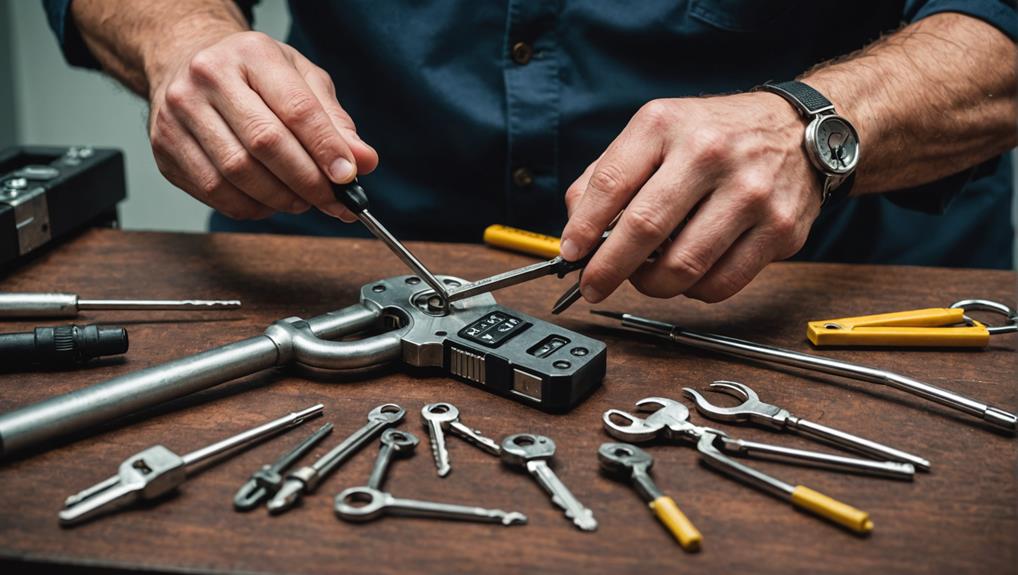To master advanced lock picking methods for professional use, you must understand the intricate mechanisms of different locks, like tubular locks, wafer locks, pin tumbler locks, and disc detainer locks. Utilize specialized tools and practice precision in manipulation. Techniques range from delicate decoding of combination locks to impressioning high-security ones. Electronic locks offer vulnerabilities that knowledgeable locksmiths exploit with specific tools. Familiarize yourself with the tools required for bypassing security measures and decoding patterns. The domain of lock manipulation awaits your exploration, revealing secrets to enhance your skills and broaden your expertise.
Key Takeaways
- Utilize specialized tools like tubular lock picks for cylindrical keyways.
- Master wafer lock manipulation with specific wafer lock pick sets.
- Understand pin tumbler locks' components like shear line for precision.
- Practice disc detainer lock manipulation for intricate mechanisms.
- Employ decoding and impressioning techniques for high-security locks.
Mastering Tubular Locks
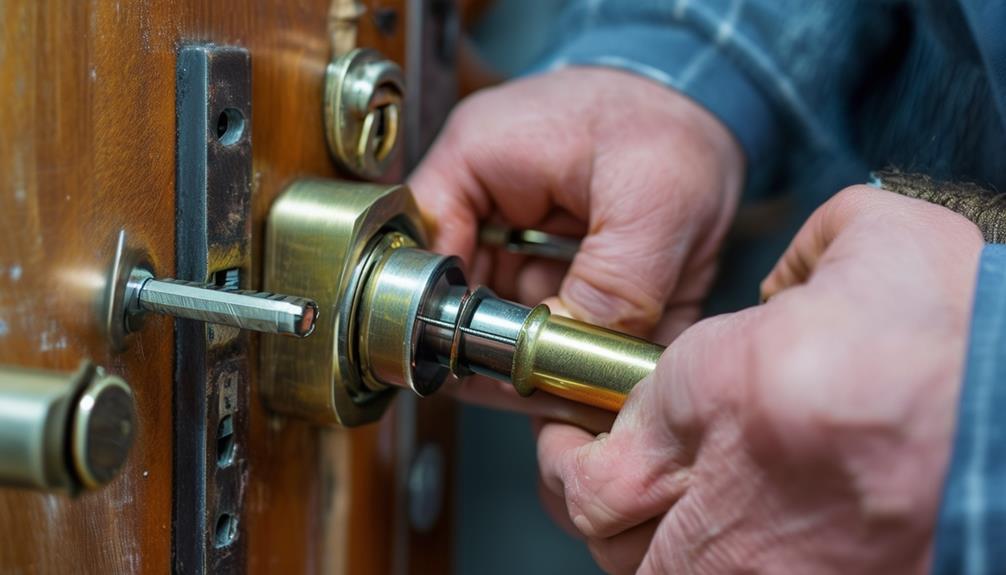
When it comes to mastering tubular locks, understanding their unique mechanisms is essential. Tubular locks have a cylindrical keyway with pins arranged in a circular pattern.
To successfully pick these locks, you must use a specialized tubular lock pick with a tension wrench. Regular practice improves lockpicking skills, making it easier to develop a feel for the subtle movements required.
Insert the pick into the keyway and apply slight pressure in the direction the key would turn. Rotate the pick slowly while pressing it inward until you feel the pins align. This process requires patience and precision to avoid oversetting the pins.
Remember, the key pins in tubular locks are set at varying depths, so pay attention to feedback from the lock as you pick it. Practice is key to mastering tubular locks, as it can be challenging to get a feel for the subtle movements required.
With dedication and persistence, you can develop the skills needed to effectively pick tubular locks.
Diving Into Wafer Locks
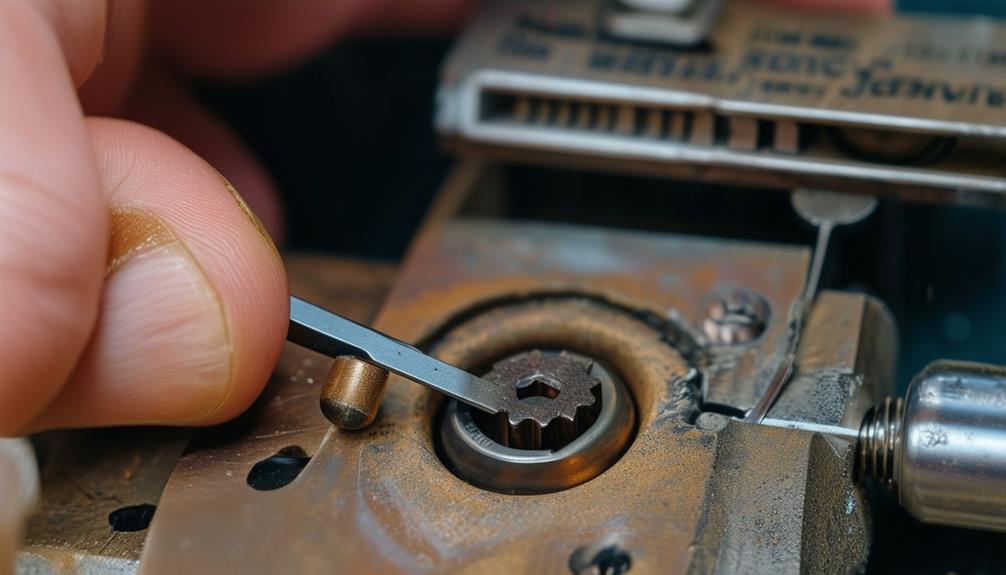
Exploring wafer locks involves understanding their unique structure and mechanisms. Wafer locks are commonly found in various applications like cabinets, desks, and even some automobiles. These locks operate using a series of flat wafers that must be aligned correctly to open the lock.
To pick a wafer lock using advanced lockpicking methods, you'll need specific tools like a wafer lock pick set designed to manipulate these wafers effectively. Regular practice improves lockpicking skills, and it's vital to master the art of tubular lock picking to broaden your proficiency in various lock types.
When approaching a wafer lock, it's important to grasp how the wafers interact within the lock cylinder. By applying tension to the lock while gently lifting each wafer to the correct height, you can gradually set all the wafers in place to release the mechanism. This method requires patience and a delicate touch to guarantee each wafer is precisely positioned.
With practice and understanding of the inner workings of wafer locks, you can enhance your skill in advanced lockpicking techniques. Mastering wafer locks adds to your expertise in handling a wider variety of locks effectively.
Precision With Pin Tumbler Locks
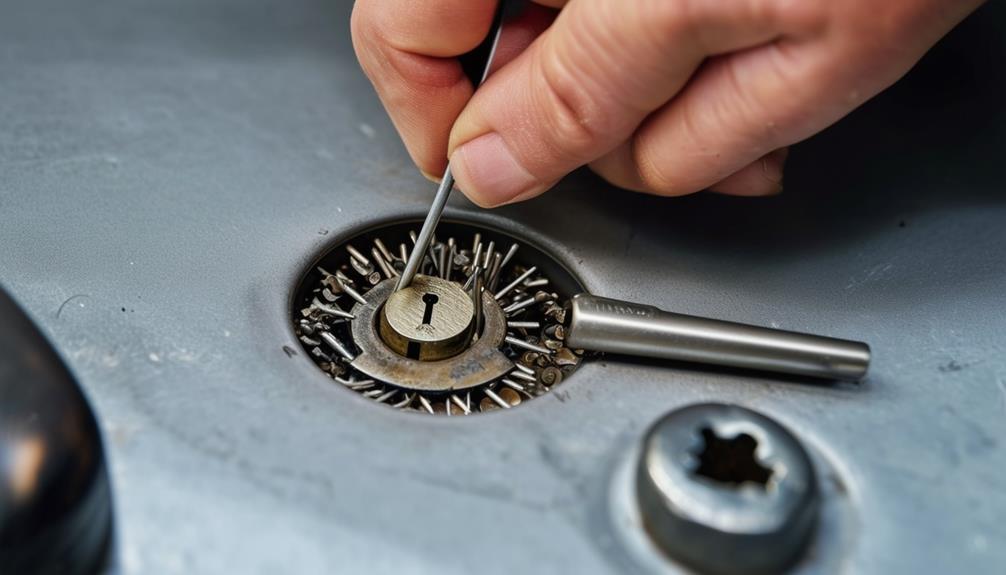
Delving into the intricacies of pin tumbler locks requires a keen eye for precision. Advanced lock picking methods demand careful attention to detail when manipulating these common types of locks. Pin tumbler locks consist of a series of spring-loaded pins of varying lengths that must be precisely aligned to allow the lock to turn.
To better understand the inner workings of pin tumbler locks, let's take a closer look at the components involved:
| Component | Description |
|---|---|
| Key Pins | Align with the cuts of the key to the shear line for the lock to open. |
| Driver Pins | Sit atop the key pins and must be lifted to the correct height. |
| Shear Line | Separates the inner cylinder from the outer casing. |
| Plug | Rotates when all pins are aligned correctly. |
Mastering the precision required to manipulate pin tumbler locks is essential for professional locksmiths utilizing advanced lock picking methods. Understanding how each component interacts within the lock is key to successfully opening these types of locks.
Manipulating Disc Detainer Locks
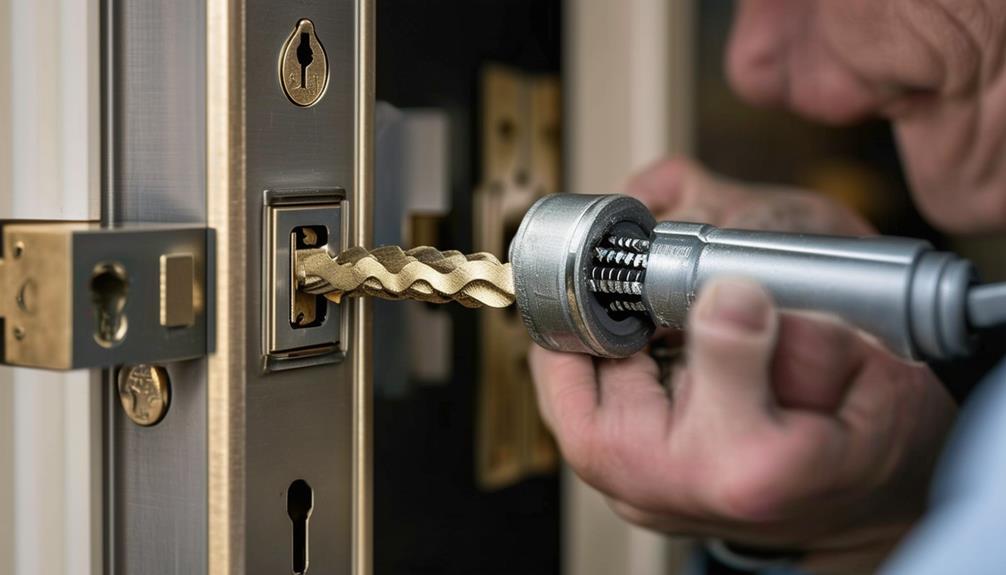
With their unique design and intricate mechanisms, disc detainer locks present a new challenge for lock picking enthusiasts. Understanding the specific security features of these locks is vital for effective manipulation.
When manipulating disc detainer locks, it's important to understand their inner workings and how to bypass their security features effectively. Here are some key techniques to master this skill:
- Rotation Attack: Apply tension to the lock while individually rotating each disc to their correct position. This method requires patience and a good sense of touch to feel for the subtle movements of the discs.
- Leveraging Tools: Use specialized tools like disc detainer picks or tension wrenches designed for these types of locks. These tools can help you manipulate the discs more precisely and efficiently, especially when considering the various tools available for high-security locks.
- Practice and Persistence: Manipulating disc detainer locks successfully takes practice and persistence. Familiarize yourself with the lock's feedback and keep refining your technique to enhance your chances of opening the lock smoothly.
Decoding Combination Locks
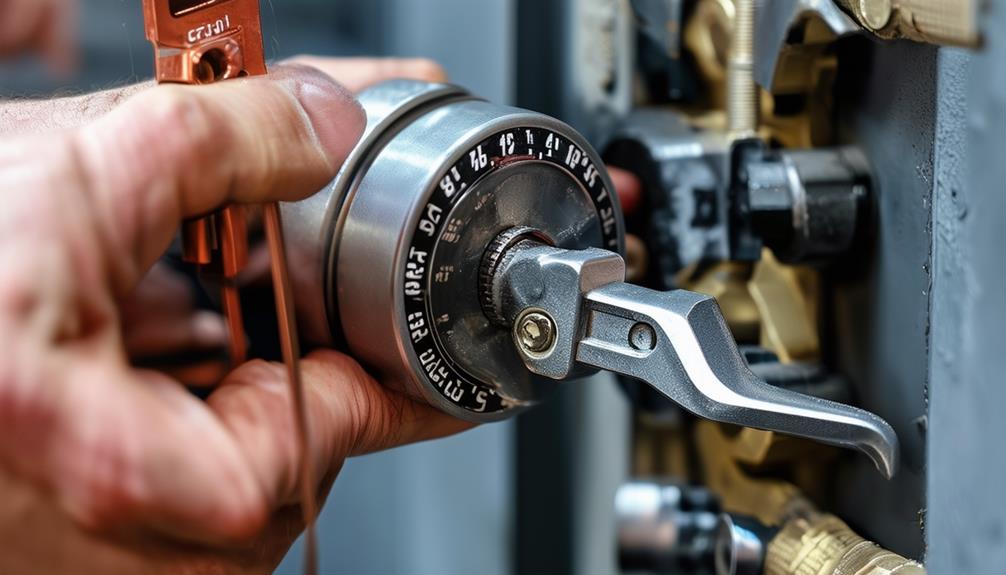
To understand the intricacies of decoding combination locks, one must first grasp the fundamental principles governing their operation.
Decoding combination locks involves determining the correct combination without the need for the original code. It requires a systematic approach and careful attention to detail, as outlined in the crafting and utilizing lock pick tools.
When decoding combination locks, it's essential to start by applying consistent and gentle pressure on the dial while turning it in the direction needed to open the lock.
Listen closely for any subtle clicks or changes in resistance, as these can indicate the correct numbers in the combination sequence. By noting these cues and testing different combinations systematically, you can gradually reveal the code.
It is vital to remain patient and methodical during the decoding process. Rushing or skipping steps can lead to errors and prolong the opening procedure.
With practice and a keen eye for detail, decoding combination locks can become a skill that you can master effectively.
Understanding Master Key Systems
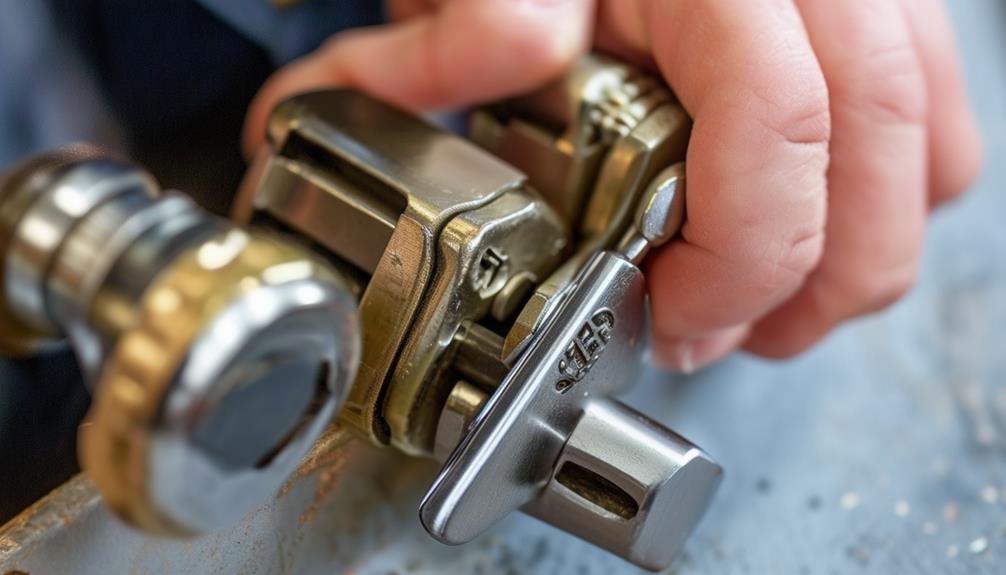
As you progress from decoding combination locks to understanding master key systems, a new domain of security mechanisms unfolds before you.
Master key systems offer a complex yet efficient way to control access to multiple areas using different levels of keys.
Master keying improves security by streamlining access for authorized personnel while minimizing unauthorized entry risks.
Here are key points to help you grasp the concept of master key systems:
- Hierarchical Structure: Master key systems are designed with a hierarchical structure where different keys can open specific locks, while a master key can gain entry to all locks within the system. This structure allows for controlled access based on the key hierarchy.
- Customization Options: Master key systems can be customized to suit specific needs, enabling organizations to manage access levels for different individuals or groups efficiently. This customization feature enhances security and operational flexibility.
- Enhanced Security: By implementing master key systems, you can enhance security by regulating access to different areas within a building or facility. This system provides a balance between convenience and security, making it a popular choice for various settings.
Bypassing Electronic Locks
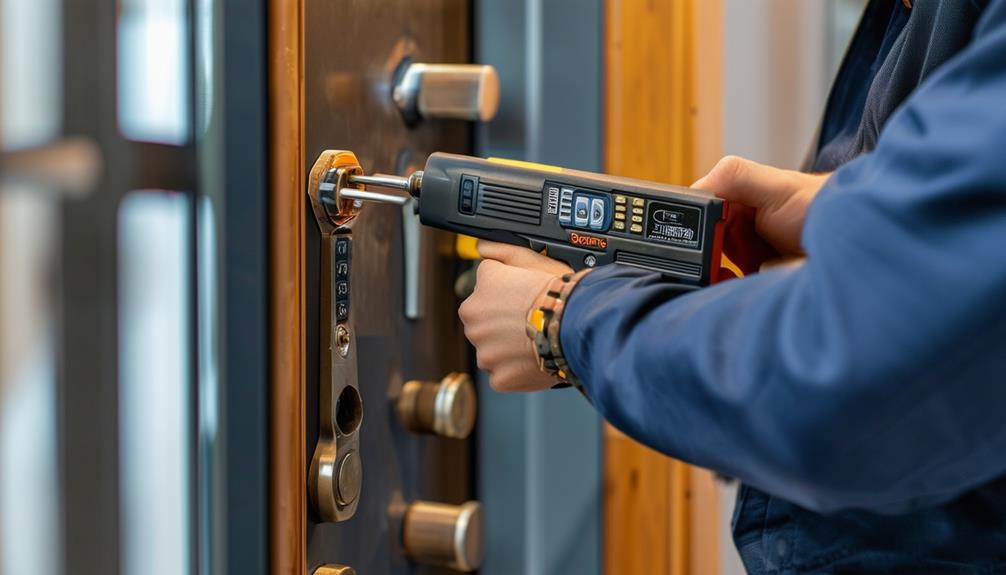
Let's explore the vulnerabilities present in electronic locks and the specialized tools that can effectively bypass their security measures.
Understanding these weaknesses and the methods used to exploit them is vital for locksmiths and security professionals.
Many electronic locks, such as magnetic locks, have specific vulnerabilities that can be targeted, making knowledge of these systems essential.
Vulnerabilities in Electronic Locks
Numerous electronic locks, despite their modern features, may still harbor vulnerabilities that can be exploited by skilled individuals. These vulnerabilities can range from design flaws to implementation errors, making it important to understand the weaknesses present in electronic lock systems.
Here are key vulnerabilities to be aware of:
- Software Vulnerabilities: Many electronic locks rely on software to function, which can be prone to bugs or vulnerabilities that hackers can exploit to gain unauthorized access.
- Communication Vulnerabilities: Wireless electronic locks often transmit data between components. If this communication isn't properly secured, it can be intercepted or manipulated by attackers.
- Physical Vulnerabilities: Even electronic locks with advanced technology can sometimes be bypassed physically, such as through bypassing the electronic components altogether or exploiting weak points in the lock's hardware.
Being aware of these vulnerabilities in electronic locks is vital for security professionals to effectively protect against unauthorized access and guarantee the safety of the assets being secured.
Tools for Bypassing Security
When faced with the challenge of bypassing electronic locks, having the right tools can make all the difference. Advanced locksmithing techniques often require specialized tools designed to manipulate electronic security systems effectively. Below is a table outlining some common tools used by professionals in the field:
| Tool | Description |
|---|---|
| Lock Pick Set | Includes various picks and tension wrenches for precise manipulation of electronic lock components. |
| Key Extractor Kit | Essential for extracting broken keys or foreign objects stuck in electronic locks without causing damage. |
| Decoder Device | Used to decode electronic lock patterns or codes, allowing for quick access without the need for traditional keys. |
| Bypass Tool | Enables the bypassing of specific electronic lock mechanisms by simulating authorized access protocols. |
These tools are instrumental in executing advanced locksmithing techniques efficiently and with precision, making them indispensable for professionals in the field of electronic lock manipulation.
Impressioning High-Security Locks
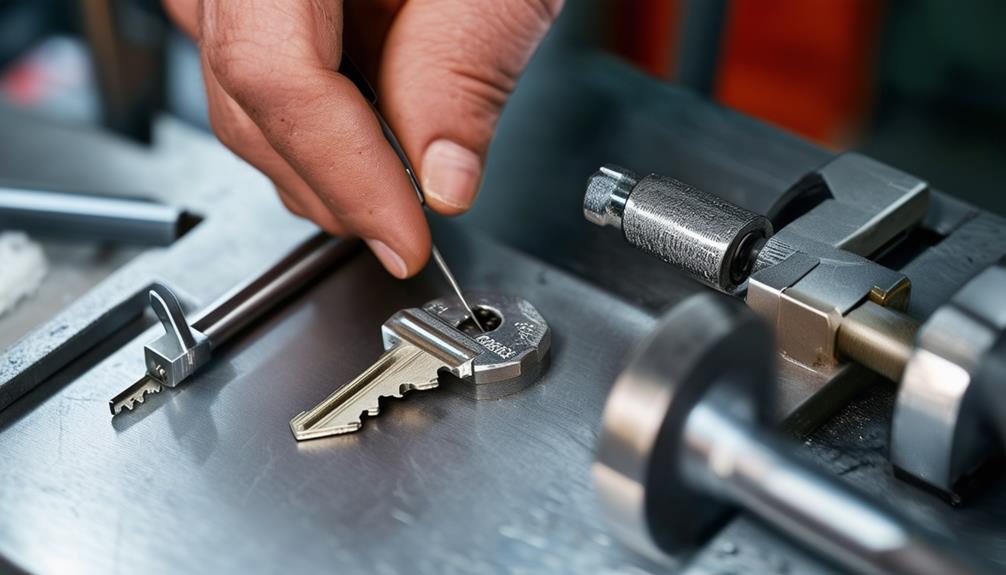
To successfully impression high-security locks, precision and patience are paramount. Impressioning involves creating a working key by making an impression of the lock's internal components, which can be quite complex due to the intricacies of high-security designs.
Understanding the nuances of different high-security locks can be beneficial for this technique, as detailed in advanced lock picking techniques.
Here are three key steps to effectively impression high-security locks:
- Select the Right Blank Key: Begin by choosing a blank key that closely matches the keyway and size of the lock you're trying to impression. Having the correct blank key is essential for the impressioning process to work smoothly.
- Apply Gentle Pressure: Insert the blank key into the lock and apply slight rotational pressure in both directions. The goal is to create marks on the key where the pins are binding. Be patient and gentle to avoid damaging the key or the lock.
- File and Test: Carefully file down the key at the marked points, testing it in the lock after each adjustment. Continue this process of impressioning, filing, and testing until the key successfully turns the lock.
Frequently Asked Questions
Can Lock Picking Damage the Lock Mechanism?
Lock picking can potentially damage the lock mechanism if done incorrectly. Excessive force or using the wrong tools may lead to broken pins or misalignment, rendering the lock unusable.
It's crucial to practice proper technique and only pick locks you have permission to access.
With the right skills and care, you can minimize the risk of damaging the lock while successfully picking it.
Are There Legal Restrictions on Owning Lock Picking Tools?
Legal restrictions on owning lock picking tools vary by location.
In some areas, it's legal to possess them as long as you're not using them for unlawful purposes.
However, other places have strict laws prohibiting their ownership, unless you're a certified locksmith or have a valid reason.
It's essential to check your local regulations to guarantee compliance and avoid any legal repercussions.
Always use lock picking tools responsibly and ethically.
How Long Does It Take to Learn Advanced Lock Picking?
To master advanced lock picking, it typically takes dedication and practice. The timeline varies depending on your existing skills and commitment level.
Generally, beginners might spend a few months learning the basics before progressing to more complex techniques. With regular practice and guidance, you could become proficient in advanced lock picking within a year or so.
Can Advanced Lock Picking Be Used for Illegal Purposes?
While advanced lock picking techniques can be used for illegal purposes, it's crucial to remember that knowledge itself isn't illegal.
However, the intent behind using such techniques can determine legality. Always verify that you're using your skills for ethical and legal purposes.
Is There a Risk of Being Locked Out While Practicing Lock Picking?
While practicing lock picking, there's a risk of being locked out if you're not careful.
Make sure you have spare keys or a backup plan in case you accidentally lock yourself out.
It's always wise to practice in a controlled environment and take necessary precautions to avoid any unwanted situations.
Stay attentive and prepared to prevent getting locked out while honing your lock picking skills.
Conclusion
Now that you've learned these advanced lock picking methods, you're equipped with the skills needed for professional use. But remember, with great power comes great responsibility. Use your knowledge wisely and ethically, as the consequences of misuse can be severe. Stay sharp and keep practicing, because you never know when your expertise in lock picking may be called upon in the future. Keep honing your skills and be prepared for whatever challenges come your way.

